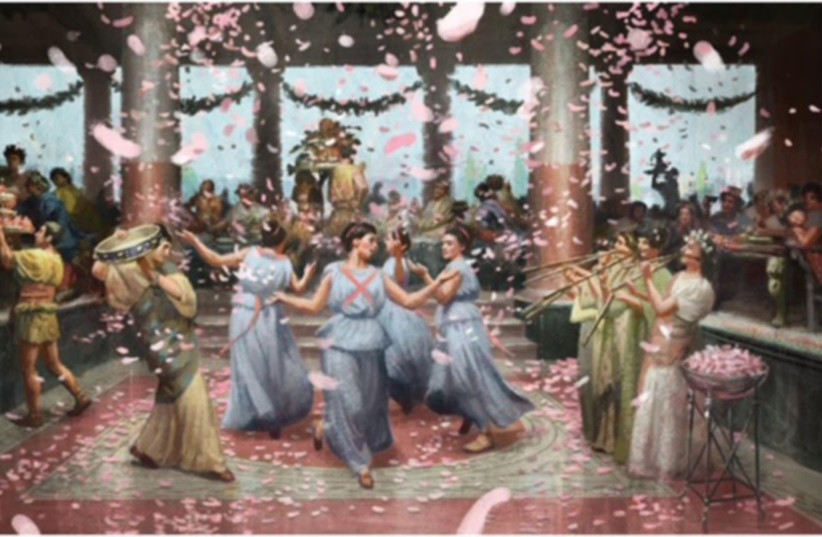Legend of Destruction, a movie by Gidi Dar about the destruction of the Second Temple that is composed of 1,500 paintings by David Polonsky and Michael Faust, is set to become the first feature-length movie where each scene will be minted as an NFT (non-fungible token).
The collection is expected to be offered for sale within two weeks and each of the film’s paintings and sketches will be available as NFTs on OpenSea, an NFT marketplace.
The film, which received four Ophir Awards in 2021, is composed of Polonsky and Faust’s paintings, as well as voices of Israeli actors including Shuli Rand (who collaborated with Dar on the script), Amos Tamam, Ze’ev Revach, Moni Moshonov and Yael Abecassis, to tell the story of the Jewish revolt against the Roman Empire, which led to war and the destruction of the Second Temple.
Dar is an acclaimed film director who collaborated with Rand on Ushpizin in 2004, while Polonsky and Faust have created artwork for Ari Folman’s Waltz with Bashir and other movies. Legend of Destruction received rave reviews, and prominent politicians, among them Prime Minister Naftali Bennett and President Isaac Herzog, have noted parallels between the historical incidents in the film and present-day Israel, urging the public to see the film.
“Our original goal was to innovate an artistic way of telling this epic historical tale, and now our vision has become transformative and accessible on the blockchain for art and history appreciation through NFTs,” said Faust.

The NFT collection includes all the paintings from the film as well as the original sketches. A pre-sale of 500 paintings and sketches will be available to community members and project partners for 48 hours. Following this pre-sale, the remaining 1,000 NFTs will be open to the public toward the end of February, with minting expected to run until early March.
After minting on the blockchain is complete, the collection will be randomly distributed among “token holders,” meaning those who purchased an NFT from the film. Each digital wallet is allowed to mint a maximum of four art pieces from the collection. The pieces will be hidden and placed into a digital box, revealing themselves 72 hours after the sale is complete to their collectors. After the reveal, collectors can continue purchasing additional paintings to complete their personal collection of full movie scenes through OpenSea.
Ido Dotan, head of digital art label ±3000, is a crypto hedge fund manager who recognized the NFT value of this unique film and masterminded the concept.
“I watched Legend of Destruction at a Tel Aviv theater. Just two still images into the movie, I turned to my best friend and business partner and we immediately recognized the immense value in converting this film into an NFT industry disruptor,” he said.
“By taking this 2,000-year-old legendary history captured in pure cinematic beauty and placing it on the blockchain, we are not only immortalizing history through the eternal blockchain, but we are also disrupting the chain by democratizing art and creativity.”
By doing so, ±3000 (and the film’s creators) are also contributing to the Ethereum blockchain’s astronomical atmosphere pollution: according to Digiconomist, a single transaction on the Ethereum blockchain has a carbon footprint of 102.38 kg. of CO2, which is equivalent to burning 53 kg. of coal. In one day, the Ethereum blockchain regularly facilitates more than 1.1 million transactions.
When Dotan refers to the idea of “democratizing art and creativity,” he addresses the notion that the traditional art gallery scene is a stuffy and exclusive world that can’t be accessed by everyone.
In an interview with Avenue Magazine, art curator Kenny Schachter elaborated on this idea, pointing out that galleries are infamous for “explaining things in a very erudite, if not pompous, fashion, in a very kind of pseudo-intellectual way, in a very exclusionary environment.”
The crypto community could never be considered pompous or pseudo-intellectual. Just this week, popular NFT community figure Dez Bryant tweeted about the humble NFTers’ cause to merely share valuable information: “I’m educating women right now about NFTs and I’m hearing these women say... my brain haven’t [sic] worked like this in weeks, months and years.... A natural genuine smile came across my face.... I’m thankful.”
Schachter went on to applaud NFTs for steering away from that culture: “Now people from all economic stripes, from every class of society and every social, political, and economic background are able to access the same people on a very simple-to-use medium.”
Truly, NFTs are one of the most economically inclusive art mediums available: according to Yahoo Finance, the average cost of an NFT on the most popular marketplace, OpenSea.io, is a mere $500 – and for just $511 (and the carbon output equivalent to consuming 38 liters of diesel fuel) you can buy an algorithmically-generated picture of a cartoon worm wearing a cowboy hat. The democratized future of art is looking bright!
